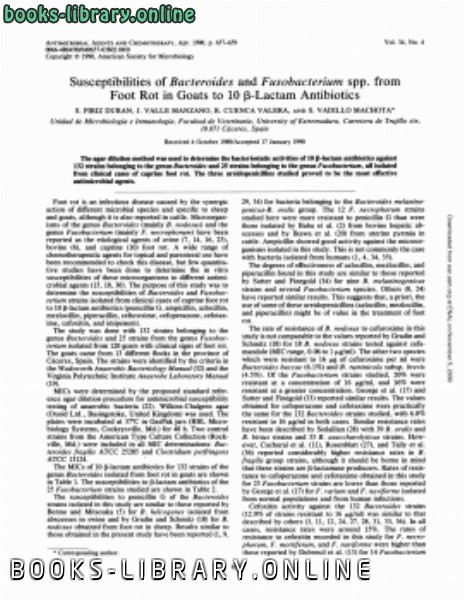

❞ كتاب Susceptibilities of Bacteroides and Fusobacterium spp. from foot rot in goats to 10 beta-lactam antibiotics. ❝
Susceptibilities of Bacteroides and Fusobacterium spp. from foot rot in goats to 10 betalactam antibiotics. من كتب طب بيطرى
Foot rot is an infectious disease caused by the synergic
action of different microbial species and specific to sheep
and goats, although it is also reported in cattle. Microorgan-
isms of the genus Bacteroides (mainly B. nodosus) and the
genus Fusobacterium (mainly F. necrophorum) have been
reported as the etiological agents of ovine (7, 14, 16, 25),
bovine (6), and caprine (10) foot rot. A wide range of
chemotherapeutic agents for topical and parenteral use have
been recommended to check this disease, but few quantita-
tive- studies have been done to determine the in vitro
susceptibilities of these microorganisms to different antimi-
crobial agents (15, 18, 30). The purpose of this study was to
determine the susceptibilities of Bacteroides and Fusobac-
terium strains isolated from clinical cases of caprine foot rot
to 10 P-lactam antibiotics (penicillin G, ampicillin, azlocillin,
mezlocillin, piperacillin, cefuroxime, cefoperazone, cefotax-
ime, cefoxitin, and imipenem).
The study was done with 132 strains belonging to the
genus Bacteroides and 25 strains from the genus Fusobac-
terium isolated from 120 goats with clinical signs of foot rot.
The goats came from 13 different flocks in the province of
Caiceres, Spain. The strains were identified by the criteria in
the Wadsworth Anaerobic Bacteriology Manual (32) and the
Virginia Polytechnic Institute Anaerobe Laboratory Manual
(19).
-
من كتب طب بيطرى - مكتبة كتب الطب.

 قبل تحميل الكتاب ..
قبل تحميل الكتاب .. 

 منصّة المكتبة
منصّة المكتبة 